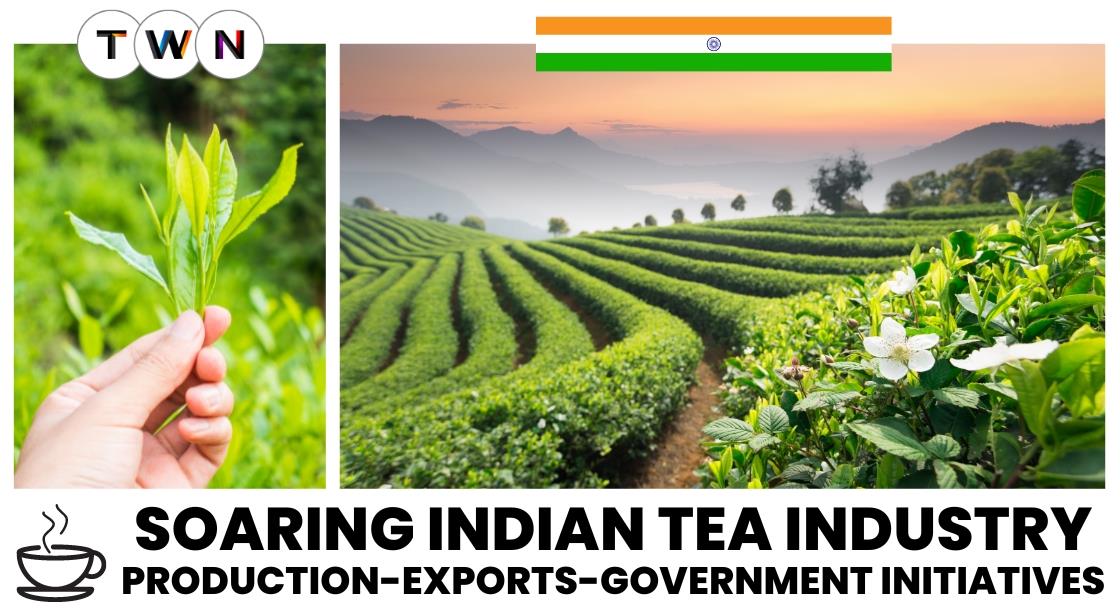Indian Tea Industry: A Steaming Success Story Of Production, Exports, And Government Support

Blog Post
Soaring Indian Tea Industry: Production, Exports, and Government Initiatives. India's thriving tea industry, globally renowned for its premium quality, has experienced significant growth in production and exports. With 80% of the tea produced in India being consumed domestically, the nation ranks among the largest tea consumers worldwide. In 2020, India's total tea production reached 1,257.52 million kg, and 1,283 million kg in the fiscal year 2020-21.
India's tea exports, valued at around US$ 687.9 million in 2021, are dominated by black tea, accounting for 96% of total exports. Major importers of Indian tea include Russia, Iran, UAE, USA, UK, Germany, and China. During 2021-22, these countries imported large quantities of tea from India, contributing to a combined total export value of US$ 277.3 million.
The Tea Board of India and various government initiatives support the Indian tea industry. The Promotion for Packaged Tea of Indian Origin scheme aids Indian exporters in marketing teas of Indian origin in overseas markets. The Tea Development and Promotion Scheme, launched in November 2021, aims to enhance productivity and quality in Indian tea production. The Tea Board of India plays a crucial role in the development of the Indian tea industry, undertaking direct promotional activities and supporting research and development.
The Indian tea industry continues to flourish with steady growth in production and exports, backed by government initiatives and the Tea Board of India. Indian tea's unique flavors and exceptional quality have made a mark in the international market, delighting tea enthusiasts across the globe.
India holds the title of the world's second-largest tea producer, renowned for its premium quality tea, due to unique geographical indications, significant investments in processing facilities, continuous innovation, product diversification, and strategic market expansion. As of 2018, tea cultivation in India spanned 6.37 lakh hectares. With 80% of the tea produced in the country consumed domestically, India ranks among the largest tea consumers globally. In 2020, India's total tea production reached 1,257.52 million kg, and 1,283 million kg in the fiscal year 2020-21.
From January-September 2022, India's tea production stood at 984.67 million kg.
Northern India, including Assam and West Bengal, contributes approximately 83% of the country's annual tea production in 2021-22. Southern India, primarily Tamil Nadu, Kerala, and Karnataka, accounts for the remaining 17%. This article delves into the flourishing Indian tea industry, exploring its production, exports, key markets, and the government's role in promoting this beloved beverage.
Indian Tea Industry: A Steaming Success Story Of Production, Exports, And Government Support
Export Trends - A Total Product Perspective
In 2021, India's tea exports were valued at around US$ 687.9 million. Renowned worldwide, Indian Assam, Darjeeling, and Nilgiri tea are highly sought-after. Black tea, accounting for 96% of total exports, dominates India's tea exports.
Other exported tea varieties include regular tea, green tea, herbal tea, masala tea, and lemon tea, with black tea, regular tea, and green tea constituting approximately 80%, 16%, and 3.5% of India's total tea exports, respectively.
India exported 201 million kg of tea during 2021-22, a 9% increase from the same period in 2021, with the January-April 2022 exports valued at US$ 215 million. In terms of quantity, India's tea exports from January-December 2021 totaled 197 million kg, with a total export value of US$ 718 million (a 1.7% increase from 2020). Between April-November 2021, India exported tea worth US$ 458.88 million.
The export price per kilogram has steadily risen over the years. During 2021-22, the unit price of tea reached US$ 3.62 per kg, compared to US$ 3.52 in the previous year, representing a 17% increase in the price per unit of tea exported from India since 2018-19.
Between April 2022-June 2022, India's total tea exports reached 65.19 million kgs, valued at US$ 236.36 million, a rise of US$ 19.77 million compared to the same period the previous year.
Export by Country
India exports tea to over 25 countries worldwide, with major importers including Russia, Iran, UAE, USA, UK, Germany, and China. During 2021-22, Russia, Ukraine, and Kazakhstan imported 32.5 million kg, 1.68 million kg, and 6.48 million kg of tea from India, respectively. During the same period, the share of Indian exports to the CIS nations accounted for 21% (42.5 million kg) of total exports. Iran, UAE, and the USA are among India's top tea export destinations. In 2021-22, these three countries imported 29.3 million kg, 23.3 million kg, and 13.5 million kg of tea from India, with a combined total export value of US$ 277.3 million.
During 2021-22, exports to Germany, the USA, UAE, and Ireland increased by 14%, 12%, 70%, and 17%, respectively, compared to the previous year. Other tea export destinations include Poland, Canada, Saudi Arabia, Egypt, Afghanistan, Bangladesh, China, Singapore, Sri Lanka, Kenya, Japan, Pakistan, and Australia, accounting for US$ 116 million of tea exports from India and contributing to 16% of the tea export revenue for 2021-22.
Government Initiatives
The Tea Board of India launched the Promotion for Packaged Tea of Indian Origin scheme to support Indian exporters marketing teas of Indian origin in overseas markets on a sustained basis. The scheme offers assistance in promotional campaigns, reimbursing up to 25% of costs for displays in international departmental stores, product literature, and website development, and inspection charges.
The Tea Board also provides subsidies for domestic exporters to participate in international fairs and exhibitions, offering a platform for showcasing products at international events and facilitating trade opportunities.
Also Read: How Technology Can Empower the Indian MSME Landscape
Tea Development and Promotion Scheme
Launched in November 2021, the Tea Development and Promotion Scheme aims to enhance productivity and quality in Indian tea production.
The scheme has seven components:
-
Plantation development for small tea farmers
-
Creation of sector-specific action plans for North East India
-
Support for tea producers and traders in market promotion activities
-
Worker's welfare
-
Research and development activities
-
Regulatory reforms
-
Establishment expenses
Governing Body – Tea Board of India
Established in 1953, the Tea Board of India plays a crucial role in the development of the Indian tea industry. The board, headquartered in Kolkata, has 17 offices across the country.
As the regulatory body, it controls producers, manufacturers, exporters, tea brokers, auction organizers, and warehouse keepers through various control orders notified under the Tea Act.
The board's responsibilities include increasing production and productivity, improving tea quality, market promotion, welfare measures for plantation workers, and supporting research and development.
In addition to its development and regulatory functions, the Tea Board of India undertakes direct promotional activities such as organizing joint participation in international fairs and exhibitions, arranging buyer-seller meets, and sending and hosting trade delegations.
It also conducts market surveys, analyzes consumer behavior, and provides importers and exporters with relevant and accurate information.
#ThinkWithNiche Editorial References include Sites- Tea Board of India, Food Safety and Standards Authority of India, and Tea Research Association.
In conclusion, the Indian tea industry continues to thrive, with steady growth in production and exports. The industry is supported by the Tea Board of India and various government initiatives aimed at promoting this popular beverage globally. With its unique flavors and exceptional quality, Indian tea has carved a niche in the international market, delighting tea connoisseurs across the globe.
You May Like
EDITOR’S CHOICE












